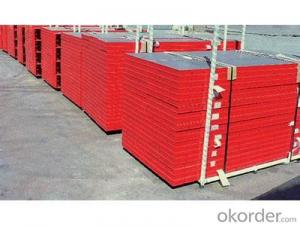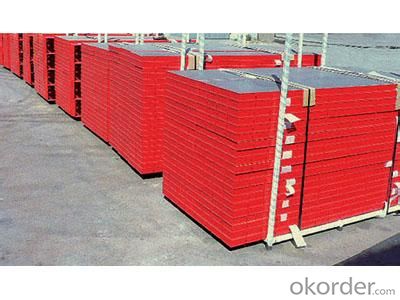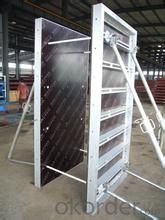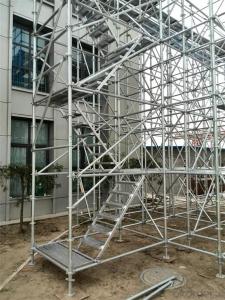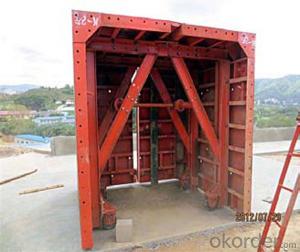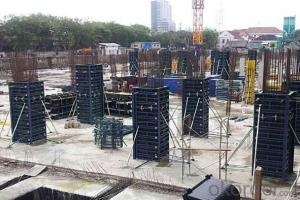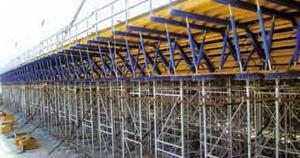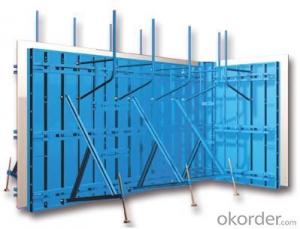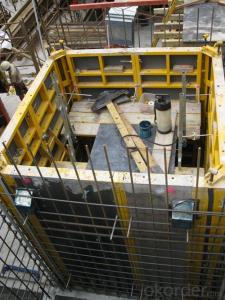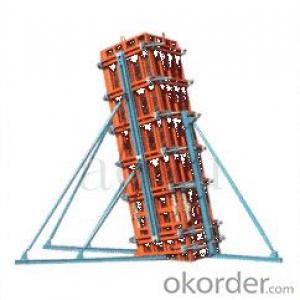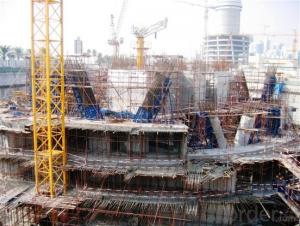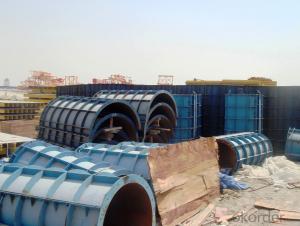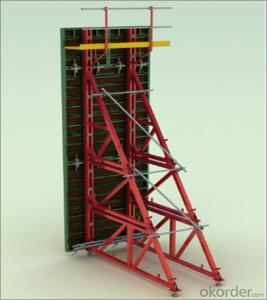Steel Fram Formworks for All Kinds of Construction
- Loading Port:
- Shanghai
- Payment Terms:
- TT OR LC
- Min Order Qty:
- 1 m²
- Supply Capability:
- 100000 m²/month
OKorder Service Pledge
OKorder Financial Service
You Might Also Like
1. Structure of Steel Frame Formwork GK120 Description
There is a prizing part designed in the corner, which can help to position and remove formwork easily.The plywood is screwed on from the back when connecting frame and plywood, so the surface of the finished concrete is perfect.The formwork series are a complete system with a full set of accessories, and can be set up flexibly according to project demand.
2. Main Features of Steel Frame Formwork GK120
-convenient for construction
-easy to control the quality
-easy, rapid and economical.
3. Steel Frame Formwork GK120 Images
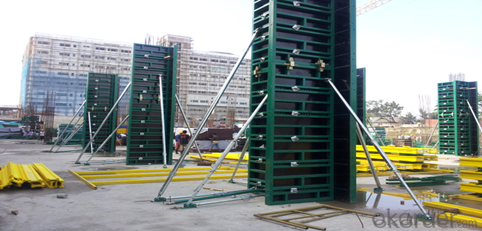
4. Steel Frame Formwork GK120Specifications
Steel Frame Formwork GK120 is used for the concrete pouring of square or rectangle column. The system has the same structure and similar connection type with wall formwork.
5.Steel Frame Formwork GK120
1) What can we do for you?
.We can ensure the quality of the Steel Frame Formwork GK120 and avoid extra expenses for customers.
.We can provide you the professional technical team.
.We can provide professional building proposal for your projects.
2) What promises can be done by us?
. If interested in this kind of formwork, please feel free to write us for any QUOTE.
. If need any technical and building assistance, we could provide on-site professional staff for instruction.
. Please DO check goods when courier knocks your door and contact us asap if any issueS.
3) What about of our after-sale services?
. Response will be carried out in 24hours after receiving any complain or request.
. Any formwork cost can be refund after order is confirmed.
. If the products are not based on the requirements, there will be the relevant compensations made for you.
4) What about the package and shipping time?
.Packing: wood package and adhesive tape
.Shipping: by sea
Shipping time: Normally small orders, it just1week business days to arrive your hand; When comes to the customs declaration, it may need 2weeks.
- Q: Can steel frame formwork be used for both precast and cast-in-place concrete beams?
- Yes, steel frame formwork can be used for both precast and cast-in-place concrete beams. Steel frame formwork is a versatile and durable system that can be easily adapted to various construction methods. For precast beams, the steel frame formwork is used to create the mold or template in which the concrete is poured and cured. Once the concrete has hardened, the formwork can be removed, leaving behind a precast beam that can be transported and installed at the construction site. Similarly, for cast-in-place concrete beams, steel frame formwork is used to create the temporary mold or template in which the concrete is poured. The formwork provides support and shape to the concrete during the pouring and curing process. Once the concrete has set, the formwork can be removed, leaving behind a cast-in-place beam that is integrated into the overall structure. Steel frame formwork offers several advantages for both precast and cast-in-place beams. It provides high strength and stability, allowing for the construction of beams with complex shapes and sizes. The steel frame formwork can be easily assembled and disassembled, making it efficient and cost-effective. Additionally, steel frame formwork is reusable, which reduces waste and promotes sustainability in construction projects. In conclusion, steel frame formwork is a suitable choice for both precast and cast-in-place concrete beams. Its versatility, durability, and ease of use make it a preferred formwork system for various construction methods.
- Q: Can steel frame formwork be used for both monolithic and modular column construction?
- Yes, steel frame formwork can be used for both monolithic and modular column construction. The versatility and strength of steel make it suitable for various construction methods, including both monolithic (pouring concrete in one continuous process) and modular (pre-fabricated components assembled on-site) column construction. Steel frame formwork provides the necessary support and stability for pouring and shaping concrete, ensuring the desired structural integrity for both construction methods.
- Q: How does steel frame formwork handle different types of formwork reinforcement?
- Steel frame formwork is highly versatile and can handle different types of formwork reinforcement effectively. The steel frame provides a strong and rigid structure that can support various types of reinforcement, such as steel bars or mesh, without any issues. It offers excellent stability and load-bearing capacity, ensuring that the formwork reinforcement remains securely in place during concrete pouring and curing. Additionally, the steel frame can be easily adjusted or modified to accommodate different reinforcement configurations, making it a suitable choice for diverse construction projects.
- Q: Glass partition, square box outsourcing 1mm thick stainless steel, glass middle is how to set the quota
- In this case, you must use the metal frame to hold the glass
- Q: Can steel frame formwork be used for precast concrete elements?
- Yes, steel frame formwork can be used for precast concrete elements. Steel frame formwork offers high strength, durability, and versatility, making it suitable for creating different shapes and sizes of precast concrete elements. Additionally, steel frame formwork provides excellent support and stability during the casting process, ensuring the accurate formation of precast concrete elements.
- Q: How does steel frame formwork handle concrete curing in humid conditions?
- Steel frame formwork is highly resistant to the effects of humid conditions during concrete curing. The steel material does not absorb moisture, preventing any potential damage or warping. Additionally, the tight joints and secure connections of steel frame formwork ensure proper sealing, minimizing the risk of moisture penetration. This allows for effective curing of concrete, resulting in a strong and durable structure even in humid environments.
- Q: Can steel frame formwork be used in combination with other building materials, such as masonry or steel?
- Yes, steel frame formwork can be used in combination with other building materials such as masonry or steel. The steel frame formwork provides a sturdy and reusable structure for concrete placement, while other materials can be used for additional structural or aesthetic purposes in the overall building construction.
- Q: How does steel frame formwork handle different types of formwork curing techniques?
- Steel frame formwork is a versatile and durable system that can effectively handle different types of formwork curing techniques. The steel frame provides excellent support and stability, allowing for various curing methods to be implemented. One common technique is the traditional wet curing method, where the formwork is kept damp with water to facilitate proper hydration of the concrete. Steel frame formwork is designed to withstand the moisture and pressure associated with wet curing. The steel frames are typically coated with anti-corrosion materials, ensuring their longevity and resilience against water exposure. Another technique is the use of curing compounds or membranes, which are applied to the formwork surface to create a barrier that retains moisture and promotes proper curing. The smooth surface of the steel frame formwork allows for easy application and adherence of these compounds. The steel frames also provide a solid base for the curing compounds to bond with, ensuring a strong and effective curing process. Additionally, steel frame formwork can accommodate the use of insulating materials for curing, such as thermal blankets or foam boards. These materials are placed on the formwork surface to retain heat and promote a controlled curing environment, especially in colder climates. The steel frame formwork provides a sturdy structure to support the weight of the insulating materials and ensures proper insulation throughout the curing process. Overall, steel frame formwork is well-suited to handle different types of formwork curing techniques. Its strength, durability, and resistance to moisture make it a reliable choice for various curing methods. Whether it is wet curing, curing compounds, or insulation, the steel frame formwork system can effectively support and facilitate the curing process, resulting in high-quality and durable concrete structures.
- Q: Can steel frame formwork be used in both horizontal and vertical applications?
- Yes, steel frame formwork can be used in both horizontal and vertical applications. Its sturdy construction and versatility make it suitable for various types of concrete structures, including slabs, walls, columns, and beams.
- Q: Can steel frame formwork be used for the construction of religious buildings?
- Certainly, religious buildings can indeed be constructed using steel frame formwork. This construction technique is incredibly versatile and long-lasting, allowing for the creation of intricate and complex designs. Religious buildings often boast unique and elaborate architecture, and steel frame formwork is well-equipped to meet these specific requirements. Furthermore, steel frame formwork offers exceptional strength and stability, which is crucial for the construction of large and iconic religious structures. Not only that, but steel is also an environmentally friendly and sustainable material, aligning perfectly with the sustainability and environmental consciousness often prioritized in religious buildings. In conclusion, steel frame formwork is a feasible choice for constructing religious buildings, providing the necessary structural integrity and aesthetic appeal necessary for such endeavors.
Send your message to us
Steel Fram Formworks for All Kinds of Construction
- Loading Port:
- Shanghai
- Payment Terms:
- TT OR LC
- Min Order Qty:
- 1 m²
- Supply Capability:
- 100000 m²/month
OKorder Service Pledge
OKorder Financial Service
Similar products
Hot products
Hot Searches
